Organisational Behaviour: Tesco Case Study Report, UK
VerifiedAdded on 2020/10/05
|12
|3220
|216
Report
AI Summary
This report provides a comprehensive analysis of organisational behaviour within Tesco, a multinational supermarket chain. It begins by examining how organisational culture, policies, and power dynamics influence individual and team behaviour, including discussions on power culture, task culture, and role culture. The report then delves into the application of French and Raven's power types within Tesco. Furthermore, it explores the impact of politics on the organisation. The second part of the report focuses on motivation theories, including content and process theories. It discusses Maslow's hierarchy of needs and reinforcement theory in the context of Tesco. Finally, the report differentiates between effective and ineffective teams, outlining key characteristics and qualities such as clear unity, effective environment, communication, and confidence. This report offers valuable insights into how these organisational behaviour concepts are applied within a real-world business setting and provides a framework for understanding and improving team dynamics and employee motivation.
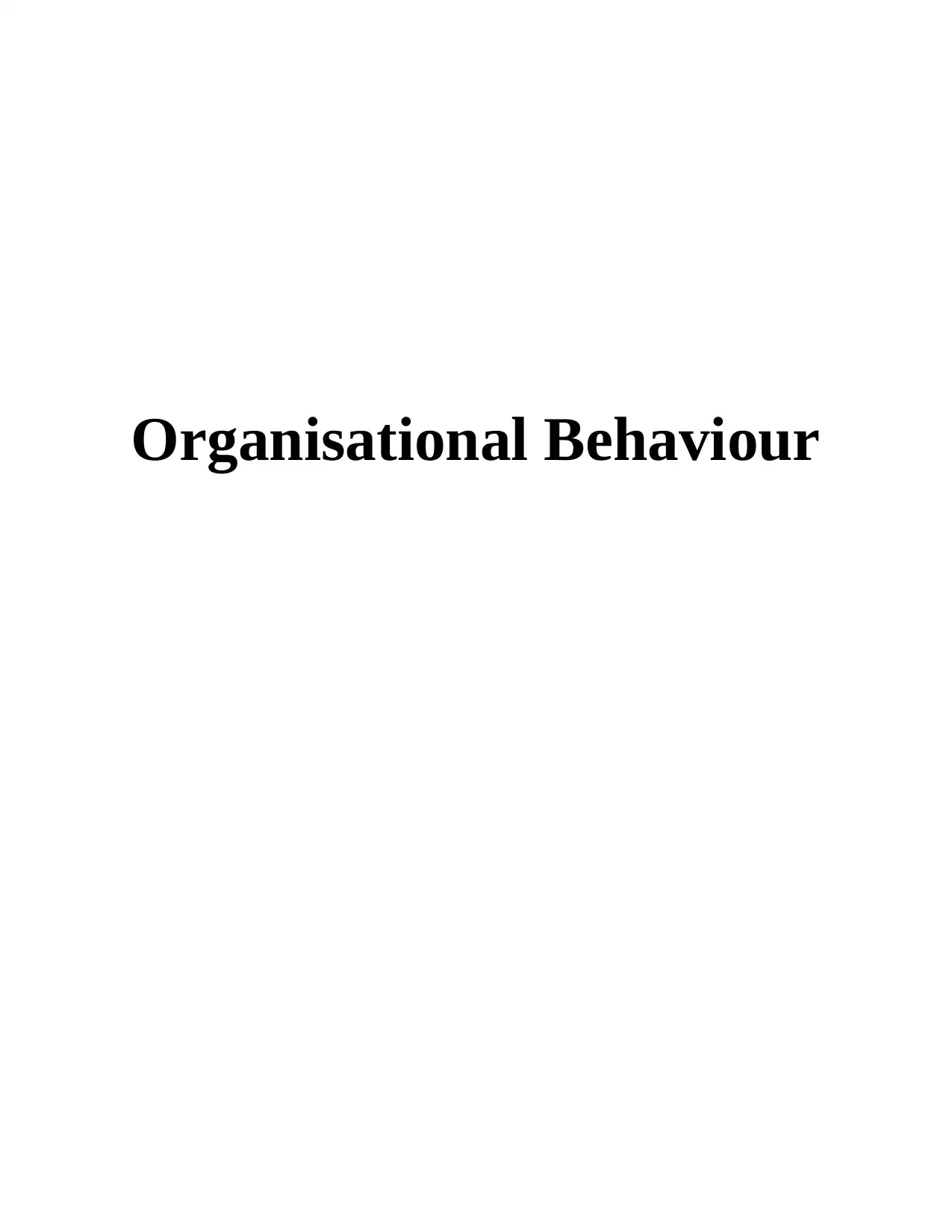
Organisational Behaviour
Paraphrase This Document
Need a fresh take? Get an instant paraphrase of this document with our AI Paraphraser
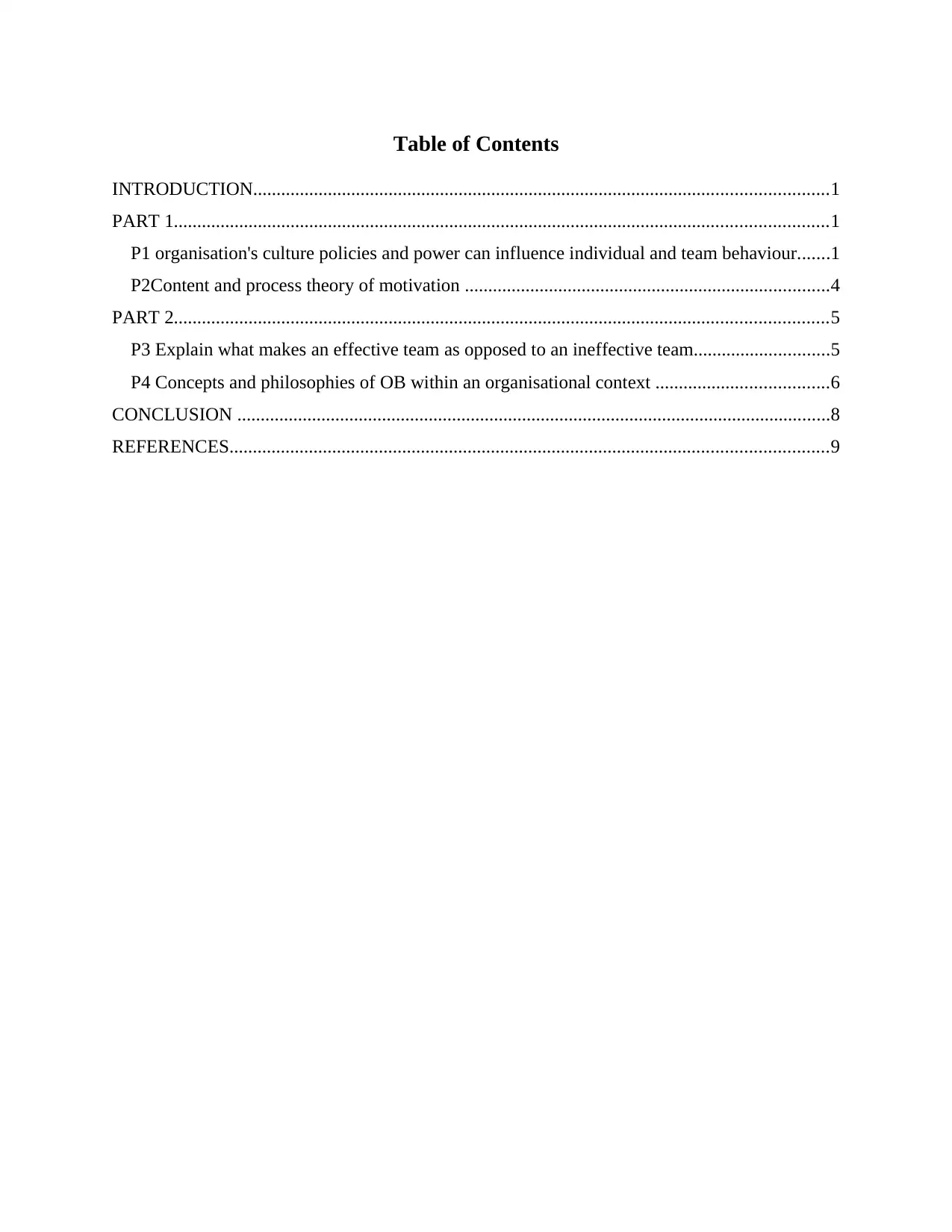
Table of Contents
INTRODUCTION...........................................................................................................................1
PART 1............................................................................................................................................1
P1 organisation's culture policies and power can influence individual and team behaviour.......1
P2Content and process theory of motivation ..............................................................................4
PART 2............................................................................................................................................5
P3 Explain what makes an effective team as opposed to an ineffective team.............................5
P4 Concepts and philosophies of OB within an organisational context .....................................6
CONCLUSION ...............................................................................................................................8
REFERENCES................................................................................................................................9
INTRODUCTION...........................................................................................................................1
PART 1............................................................................................................................................1
P1 organisation's culture policies and power can influence individual and team behaviour.......1
P2Content and process theory of motivation ..............................................................................4
PART 2............................................................................................................................................5
P3 Explain what makes an effective team as opposed to an ineffective team.............................5
P4 Concepts and philosophies of OB within an organisational context .....................................6
CONCLUSION ...............................................................................................................................8
REFERENCES................................................................................................................................9

⊘ This is a preview!⊘
Do you want full access?
Subscribe today to unlock all pages.

Trusted by 1+ million students worldwide
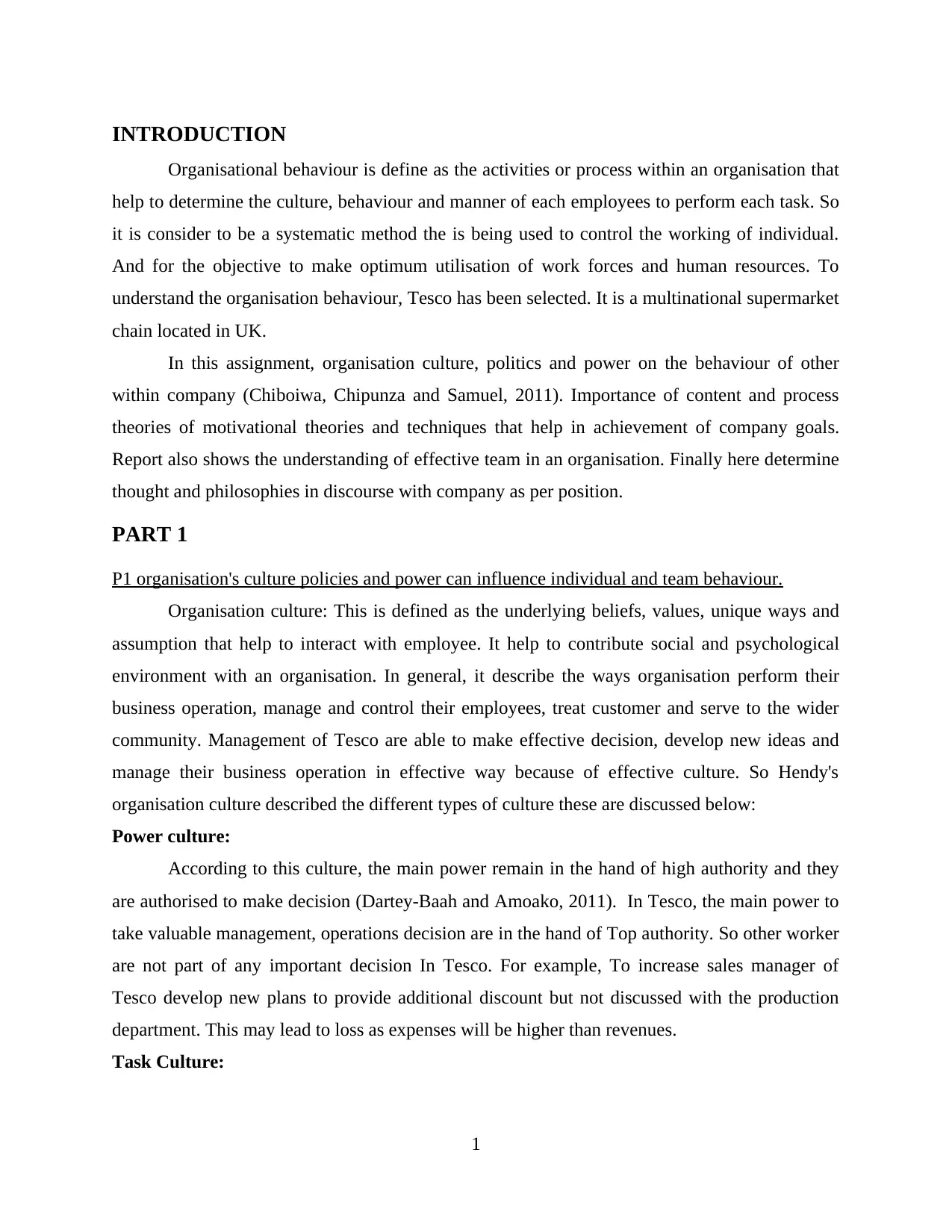
INTRODUCTION
Organisational behaviour is define as the activities or process within an organisation that
help to determine the culture, behaviour and manner of each employees to perform each task. So
it is consider to be a systematic method the is being used to control the working of individual.
And for the objective to make optimum utilisation of work forces and human resources. To
understand the organisation behaviour, Tesco has been selected. It is a multinational supermarket
chain located in UK.
In this assignment, organisation culture, politics and power on the behaviour of other
within company (Chiboiwa, Chipunza and Samuel, 2011). Importance of content and process
theories of motivational theories and techniques that help in achievement of company goals.
Report also shows the understanding of effective team in an organisation. Finally here determine
thought and philosophies in discourse with company as per position.
PART 1
P1 organisation's culture policies and power can influence individual and team behaviour.
Organisation culture: This is defined as the underlying beliefs, values, unique ways and
assumption that help to interact with employee. It help to contribute social and psychological
environment with an organisation. In general, it describe the ways organisation perform their
business operation, manage and control their employees, treat customer and serve to the wider
community. Management of Tesco are able to make effective decision, develop new ideas and
manage their business operation in effective way because of effective culture. So Hendy's
organisation culture described the different types of culture these are discussed below:
Power culture:
According to this culture, the main power remain in the hand of high authority and they
are authorised to make decision (Dartey-Baah and Amoako, 2011). In Tesco, the main power to
take valuable management, operations decision are in the hand of Top authority. So other worker
are not part of any important decision In Tesco. For example, To increase sales manager of
Tesco develop new plans to provide additional discount but not discussed with the production
department. This may lead to loss as expenses will be higher than revenues.
Task Culture:
1
Organisational behaviour is define as the activities or process within an organisation that
help to determine the culture, behaviour and manner of each employees to perform each task. So
it is consider to be a systematic method the is being used to control the working of individual.
And for the objective to make optimum utilisation of work forces and human resources. To
understand the organisation behaviour, Tesco has been selected. It is a multinational supermarket
chain located in UK.
In this assignment, organisation culture, politics and power on the behaviour of other
within company (Chiboiwa, Chipunza and Samuel, 2011). Importance of content and process
theories of motivational theories and techniques that help in achievement of company goals.
Report also shows the understanding of effective team in an organisation. Finally here determine
thought and philosophies in discourse with company as per position.
PART 1
P1 organisation's culture policies and power can influence individual and team behaviour.
Organisation culture: This is defined as the underlying beliefs, values, unique ways and
assumption that help to interact with employee. It help to contribute social and psychological
environment with an organisation. In general, it describe the ways organisation perform their
business operation, manage and control their employees, treat customer and serve to the wider
community. Management of Tesco are able to make effective decision, develop new ideas and
manage their business operation in effective way because of effective culture. So Hendy's
organisation culture described the different types of culture these are discussed below:
Power culture:
According to this culture, the main power remain in the hand of high authority and they
are authorised to make decision (Dartey-Baah and Amoako, 2011). In Tesco, the main power to
take valuable management, operations decision are in the hand of Top authority. So other worker
are not part of any important decision In Tesco. For example, To increase sales manager of
Tesco develop new plans to provide additional discount but not discussed with the production
department. This may lead to loss as expenses will be higher than revenues.
Task Culture:
1
Paraphrase This Document
Need a fresh take? Get an instant paraphrase of this document with our AI Paraphraser
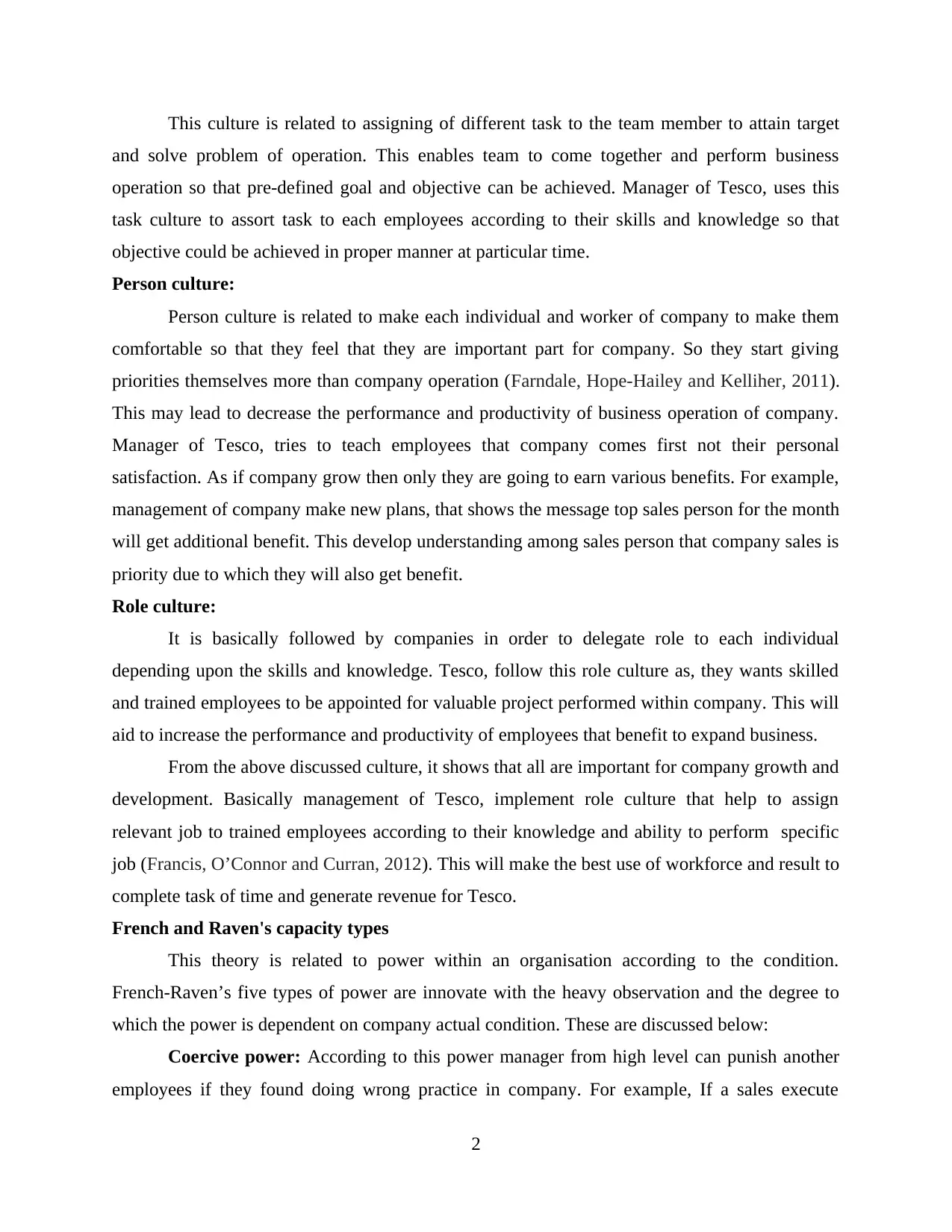
This culture is related to assigning of different task to the team member to attain target
and solve problem of operation. This enables team to come together and perform business
operation so that pre-defined goal and objective can be achieved. Manager of Tesco, uses this
task culture to assort task to each employees according to their skills and knowledge so that
objective could be achieved in proper manner at particular time.
Person culture:
Person culture is related to make each individual and worker of company to make them
comfortable so that they feel that they are important part for company. So they start giving
priorities themselves more than company operation (Farndale, Hope-Hailey and Kelliher, 2011).
This may lead to decrease the performance and productivity of business operation of company.
Manager of Tesco, tries to teach employees that company comes first not their personal
satisfaction. As if company grow then only they are going to earn various benefits. For example,
management of company make new plans, that shows the message top sales person for the month
will get additional benefit. This develop understanding among sales person that company sales is
priority due to which they will also get benefit.
Role culture:
It is basically followed by companies in order to delegate role to each individual
depending upon the skills and knowledge. Tesco, follow this role culture as, they wants skilled
and trained employees to be appointed for valuable project performed within company. This will
aid to increase the performance and productivity of employees that benefit to expand business.
From the above discussed culture, it shows that all are important for company growth and
development. Basically management of Tesco, implement role culture that help to assign
relevant job to trained employees according to their knowledge and ability to perform specific
job (Francis, O’Connor and Curran, 2012). This will make the best use of workforce and result to
complete task of time and generate revenue for Tesco.
French and Raven's capacity types
This theory is related to power within an organisation according to the condition.
French-Raven’s five types of power are innovate with the heavy observation and the degree to
which the power is dependent on company actual condition. These are discussed below:
Coercive power: According to this power manager from high level can punish another
employees if they found doing wrong practice in company. For example, If a sales execute
2
and solve problem of operation. This enables team to come together and perform business
operation so that pre-defined goal and objective can be achieved. Manager of Tesco, uses this
task culture to assort task to each employees according to their skills and knowledge so that
objective could be achieved in proper manner at particular time.
Person culture:
Person culture is related to make each individual and worker of company to make them
comfortable so that they feel that they are important part for company. So they start giving
priorities themselves more than company operation (Farndale, Hope-Hailey and Kelliher, 2011).
This may lead to decrease the performance and productivity of business operation of company.
Manager of Tesco, tries to teach employees that company comes first not their personal
satisfaction. As if company grow then only they are going to earn various benefits. For example,
management of company make new plans, that shows the message top sales person for the month
will get additional benefit. This develop understanding among sales person that company sales is
priority due to which they will also get benefit.
Role culture:
It is basically followed by companies in order to delegate role to each individual
depending upon the skills and knowledge. Tesco, follow this role culture as, they wants skilled
and trained employees to be appointed for valuable project performed within company. This will
aid to increase the performance and productivity of employees that benefit to expand business.
From the above discussed culture, it shows that all are important for company growth and
development. Basically management of Tesco, implement role culture that help to assign
relevant job to trained employees according to their knowledge and ability to perform specific
job (Francis, O’Connor and Curran, 2012). This will make the best use of workforce and result to
complete task of time and generate revenue for Tesco.
French and Raven's capacity types
This theory is related to power within an organisation according to the condition.
French-Raven’s five types of power are innovate with the heavy observation and the degree to
which the power is dependent on company actual condition. These are discussed below:
Coercive power: According to this power manager from high level can punish another
employees if they found doing wrong practice in company. For example, If a sales execute
2
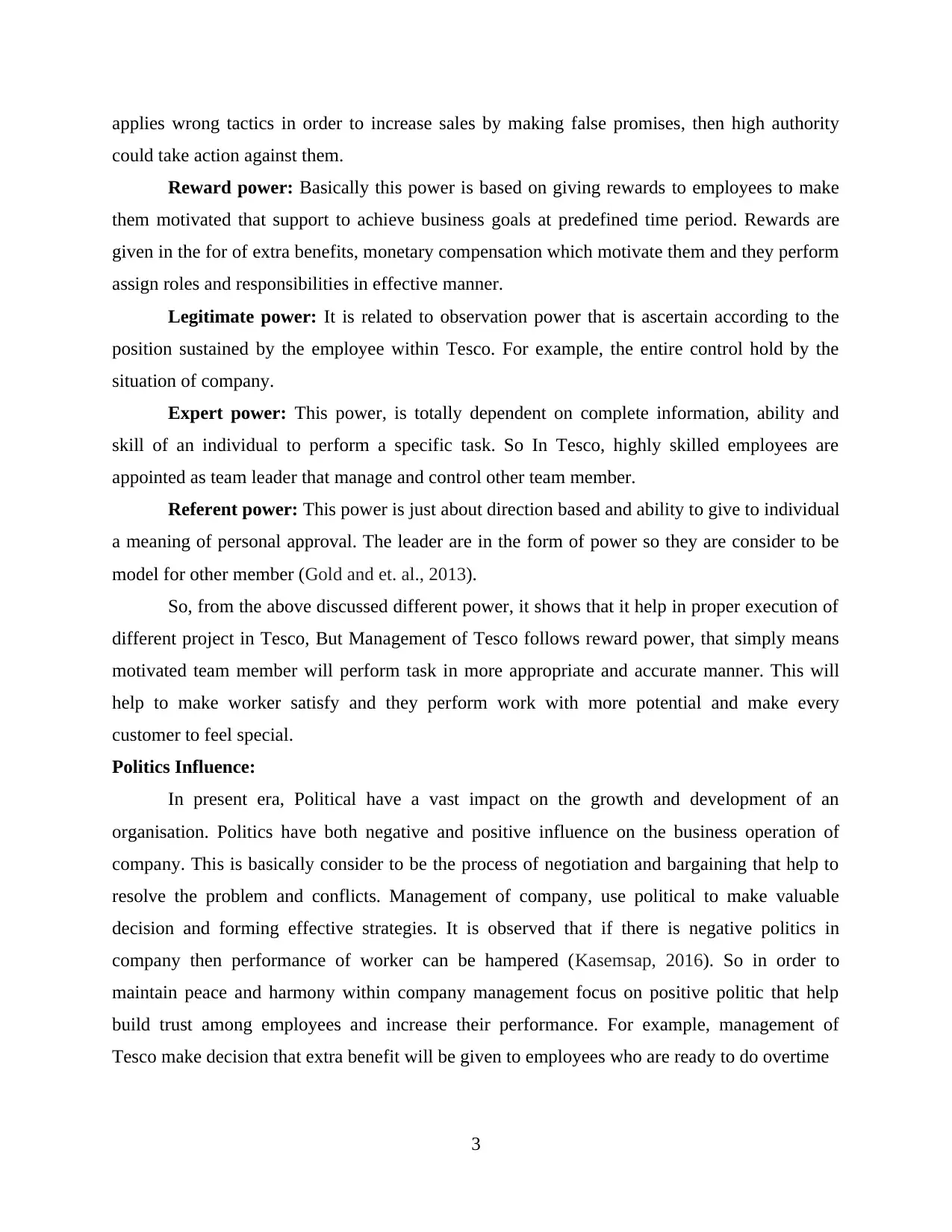
applies wrong tactics in order to increase sales by making false promises, then high authority
could take action against them.
Reward power: Basically this power is based on giving rewards to employees to make
them motivated that support to achieve business goals at predefined time period. Rewards are
given in the for of extra benefits, monetary compensation which motivate them and they perform
assign roles and responsibilities in effective manner.
Legitimate power: It is related to observation power that is ascertain according to the
position sustained by the employee within Tesco. For example, the entire control hold by the
situation of company.
Expert power: This power, is totally dependent on complete information, ability and
skill of an individual to perform a specific task. So In Tesco, highly skilled employees are
appointed as team leader that manage and control other team member.
Referent power: This power is just about direction based and ability to give to individual
a meaning of personal approval. The leader are in the form of power so they are consider to be
model for other member (Gold and et. al., 2013).
So, from the above discussed different power, it shows that it help in proper execution of
different project in Tesco, But Management of Tesco follows reward power, that simply means
motivated team member will perform task in more appropriate and accurate manner. This will
help to make worker satisfy and they perform work with more potential and make every
customer to feel special.
Politics Influence:
In present era, Political have a vast impact on the growth and development of an
organisation. Politics have both negative and positive influence on the business operation of
company. This is basically consider to be the process of negotiation and bargaining that help to
resolve the problem and conflicts. Management of company, use political to make valuable
decision and forming effective strategies. It is observed that if there is negative politics in
company then performance of worker can be hampered (Kasemsap, 2016). So in order to
maintain peace and harmony within company management focus on positive politic that help
build trust among employees and increase their performance. For example, management of
Tesco make decision that extra benefit will be given to employees who are ready to do overtime
3
could take action against them.
Reward power: Basically this power is based on giving rewards to employees to make
them motivated that support to achieve business goals at predefined time period. Rewards are
given in the for of extra benefits, monetary compensation which motivate them and they perform
assign roles and responsibilities in effective manner.
Legitimate power: It is related to observation power that is ascertain according to the
position sustained by the employee within Tesco. For example, the entire control hold by the
situation of company.
Expert power: This power, is totally dependent on complete information, ability and
skill of an individual to perform a specific task. So In Tesco, highly skilled employees are
appointed as team leader that manage and control other team member.
Referent power: This power is just about direction based and ability to give to individual
a meaning of personal approval. The leader are in the form of power so they are consider to be
model for other member (Gold and et. al., 2013).
So, from the above discussed different power, it shows that it help in proper execution of
different project in Tesco, But Management of Tesco follows reward power, that simply means
motivated team member will perform task in more appropriate and accurate manner. This will
help to make worker satisfy and they perform work with more potential and make every
customer to feel special.
Politics Influence:
In present era, Political have a vast impact on the growth and development of an
organisation. Politics have both negative and positive influence on the business operation of
company. This is basically consider to be the process of negotiation and bargaining that help to
resolve the problem and conflicts. Management of company, use political to make valuable
decision and forming effective strategies. It is observed that if there is negative politics in
company then performance of worker can be hampered (Kasemsap, 2016). So in order to
maintain peace and harmony within company management focus on positive politic that help
build trust among employees and increase their performance. For example, management of
Tesco make decision that extra benefit will be given to employees who are ready to do overtime
3
⊘ This is a preview!⊘
Do you want full access?
Subscribe today to unlock all pages.

Trusted by 1+ million students worldwide
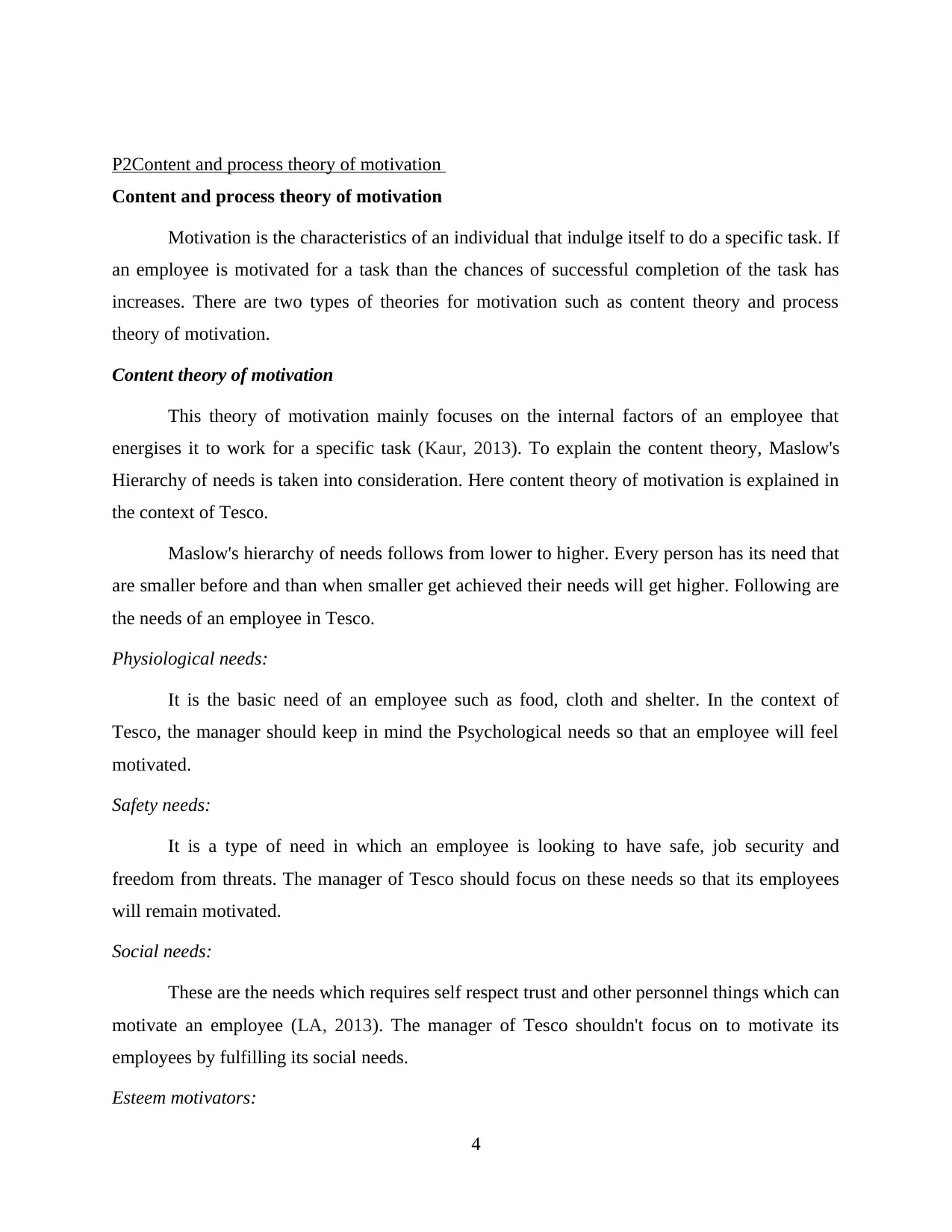
P2Content and process theory of motivation
Content and process theory of motivation
Motivation is the characteristics of an individual that indulge itself to do a specific task. If
an employee is motivated for a task than the chances of successful completion of the task has
increases. There are two types of theories for motivation such as content theory and process
theory of motivation.
Content theory of motivation
This theory of motivation mainly focuses on the internal factors of an employee that
energises it to work for a specific task (Kaur, 2013). To explain the content theory, Maslow's
Hierarchy of needs is taken into consideration. Here content theory of motivation is explained in
the context of Tesco.
Maslow's hierarchy of needs follows from lower to higher. Every person has its need that
are smaller before and than when smaller get achieved their needs will get higher. Following are
the needs of an employee in Tesco.
Physiological needs:
It is the basic need of an employee such as food, cloth and shelter. In the context of
Tesco, the manager should keep in mind the Psychological needs so that an employee will feel
motivated.
Safety needs:
It is a type of need in which an employee is looking to have safe, job security and
freedom from threats. The manager of Tesco should focus on these needs so that its employees
will remain motivated.
Social needs:
These are the needs which requires self respect trust and other personnel things which can
motivate an employee (LA, 2013). The manager of Tesco shouldn't focus on to motivate its
employees by fulfilling its social needs.
Esteem motivators:
4
Content and process theory of motivation
Motivation is the characteristics of an individual that indulge itself to do a specific task. If
an employee is motivated for a task than the chances of successful completion of the task has
increases. There are two types of theories for motivation such as content theory and process
theory of motivation.
Content theory of motivation
This theory of motivation mainly focuses on the internal factors of an employee that
energises it to work for a specific task (Kaur, 2013). To explain the content theory, Maslow's
Hierarchy of needs is taken into consideration. Here content theory of motivation is explained in
the context of Tesco.
Maslow's hierarchy of needs follows from lower to higher. Every person has its need that
are smaller before and than when smaller get achieved their needs will get higher. Following are
the needs of an employee in Tesco.
Physiological needs:
It is the basic need of an employee such as food, cloth and shelter. In the context of
Tesco, the manager should keep in mind the Psychological needs so that an employee will feel
motivated.
Safety needs:
It is a type of need in which an employee is looking to have safe, job security and
freedom from threats. The manager of Tesco should focus on these needs so that its employees
will remain motivated.
Social needs:
These are the needs which requires self respect trust and other personnel things which can
motivate an employee (LA, 2013). The manager of Tesco shouldn't focus on to motivate its
employees by fulfilling its social needs.
Esteem motivators:
4
Paraphrase This Document
Need a fresh take? Get an instant paraphrase of this document with our AI Paraphraser
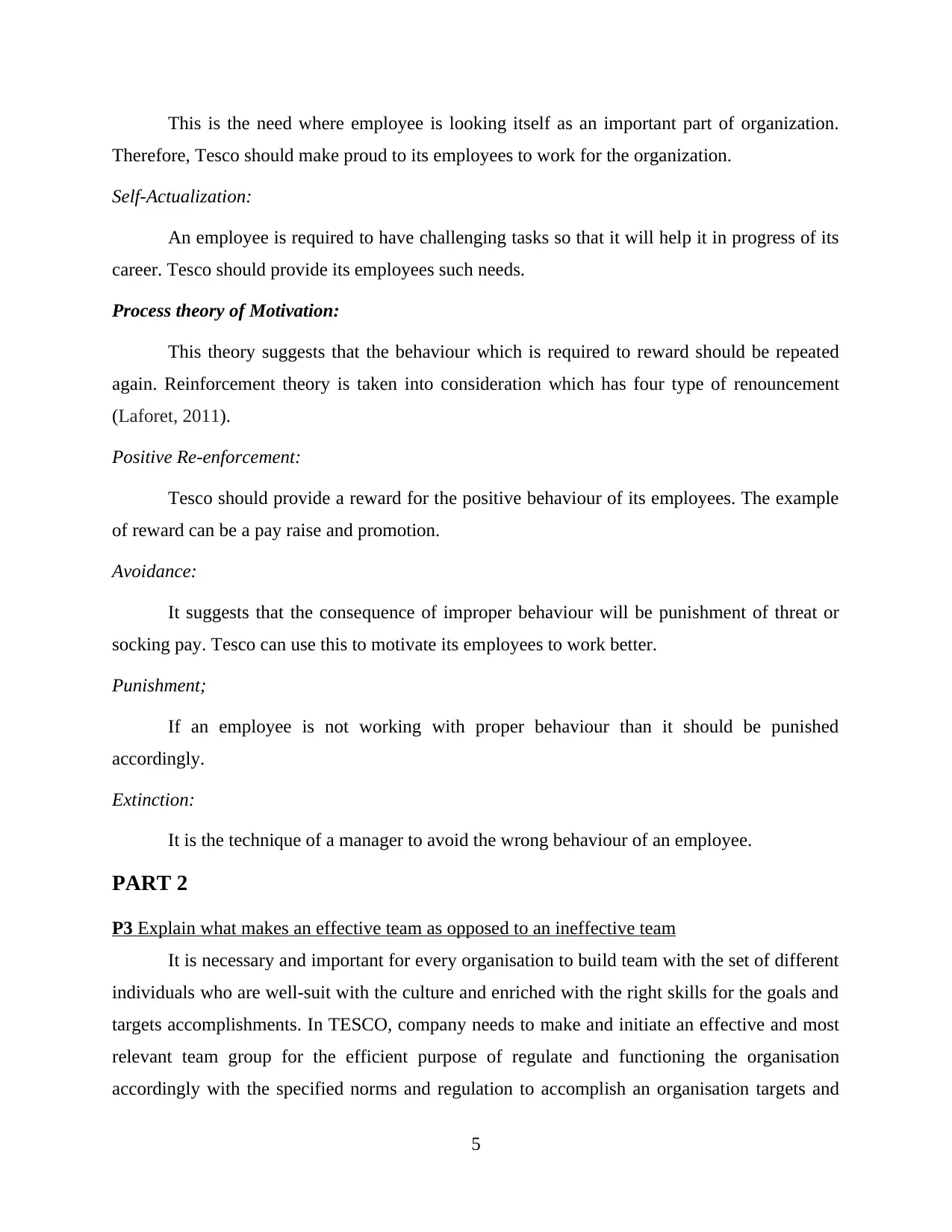
This is the need where employee is looking itself as an important part of organization.
Therefore, Tesco should make proud to its employees to work for the organization.
Self-Actualization:
An employee is required to have challenging tasks so that it will help it in progress of its
career. Tesco should provide its employees such needs.
Process theory of Motivation:
This theory suggests that the behaviour which is required to reward should be repeated
again. Reinforcement theory is taken into consideration which has four type of renouncement
(Laforet, 2011).
Positive Re-enforcement:
Tesco should provide a reward for the positive behaviour of its employees. The example
of reward can be a pay raise and promotion.
Avoidance:
It suggests that the consequence of improper behaviour will be punishment of threat or
socking pay. Tesco can use this to motivate its employees to work better.
Punishment;
If an employee is not working with proper behaviour than it should be punished
accordingly.
Extinction:
It is the technique of a manager to avoid the wrong behaviour of an employee.
PART 2
P3 Explain what makes an effective team as opposed to an ineffective team
It is necessary and important for every organisation to build team with the set of different
individuals who are well-suit with the culture and enriched with the right skills for the goals and
targets accomplishments. In TESCO, company needs to make and initiate an effective and most
relevant team group for the efficient purpose of regulate and functioning the organisation
accordingly with the specified norms and regulation to accomplish an organisation targets and
5
Therefore, Tesco should make proud to its employees to work for the organization.
Self-Actualization:
An employee is required to have challenging tasks so that it will help it in progress of its
career. Tesco should provide its employees such needs.
Process theory of Motivation:
This theory suggests that the behaviour which is required to reward should be repeated
again. Reinforcement theory is taken into consideration which has four type of renouncement
(Laforet, 2011).
Positive Re-enforcement:
Tesco should provide a reward for the positive behaviour of its employees. The example
of reward can be a pay raise and promotion.
Avoidance:
It suggests that the consequence of improper behaviour will be punishment of threat or
socking pay. Tesco can use this to motivate its employees to work better.
Punishment;
If an employee is not working with proper behaviour than it should be punished
accordingly.
Extinction:
It is the technique of a manager to avoid the wrong behaviour of an employee.
PART 2
P3 Explain what makes an effective team as opposed to an ineffective team
It is necessary and important for every organisation to build team with the set of different
individuals who are well-suit with the culture and enriched with the right skills for the goals and
targets accomplishments. In TESCO, company needs to make and initiate an effective and most
relevant team group for the efficient purpose of regulate and functioning the organisation
accordingly with the specified norms and regulation to accomplish an organisation targets and
5
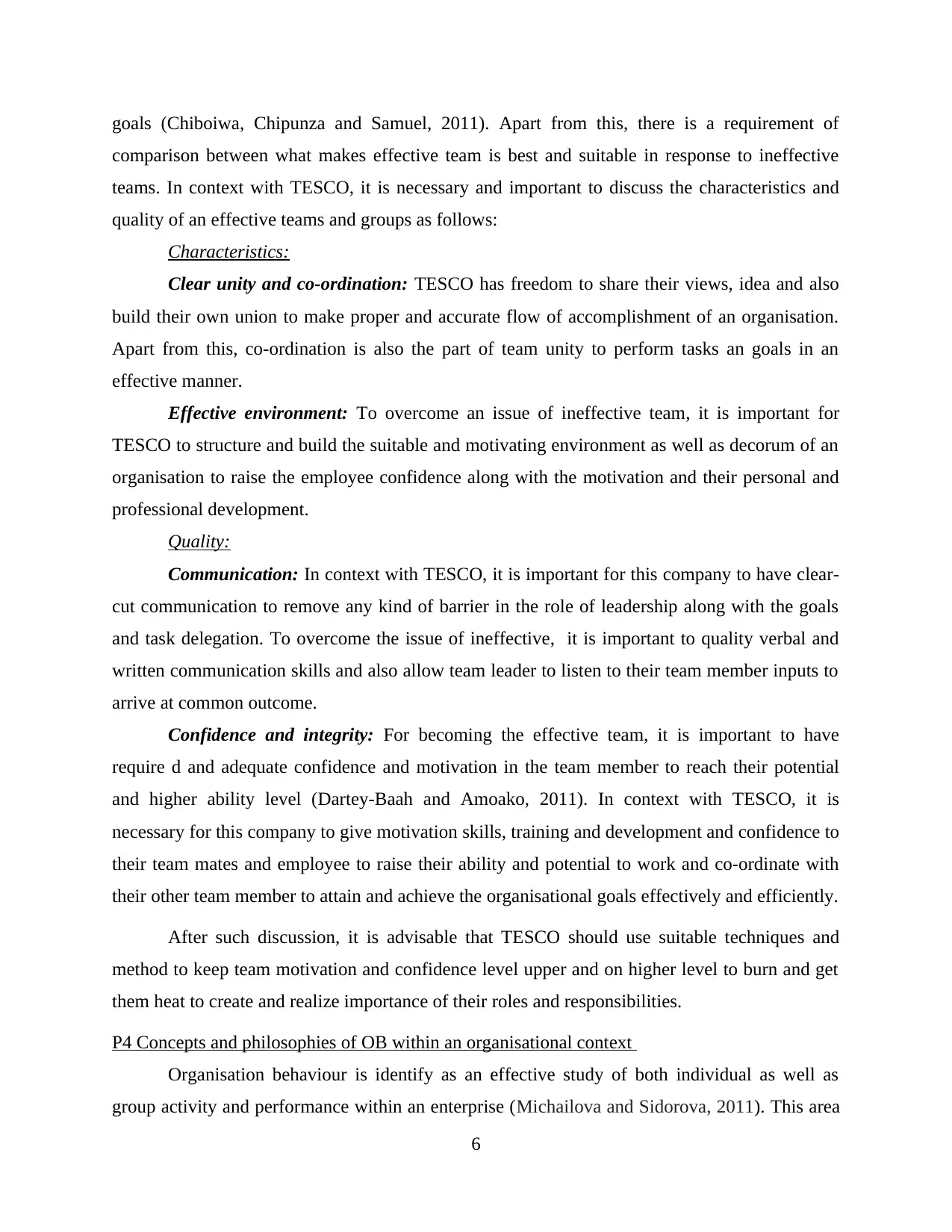
goals (Chiboiwa, Chipunza and Samuel, 2011). Apart from this, there is a requirement of
comparison between what makes effective team is best and suitable in response to ineffective
teams. In context with TESCO, it is necessary and important to discuss the characteristics and
quality of an effective teams and groups as follows:
Characteristics:
Clear unity and co-ordination: TESCO has freedom to share their views, idea and also
build their own union to make proper and accurate flow of accomplishment of an organisation.
Apart from this, co-ordination is also the part of team unity to perform tasks an goals in an
effective manner.
Effective environment: To overcome an issue of ineffective team, it is important for
TESCO to structure and build the suitable and motivating environment as well as decorum of an
organisation to raise the employee confidence along with the motivation and their personal and
professional development.
Quality:
Communication: In context with TESCO, it is important for this company to have clear-
cut communication to remove any kind of barrier in the role of leadership along with the goals
and task delegation. To overcome the issue of ineffective, it is important to quality verbal and
written communication skills and also allow team leader to listen to their team member inputs to
arrive at common outcome.
Confidence and integrity: For becoming the effective team, it is important to have
require d and adequate confidence and motivation in the team member to reach their potential
and higher ability level (Dartey-Baah and Amoako, 2011). In context with TESCO, it is
necessary for this company to give motivation skills, training and development and confidence to
their team mates and employee to raise their ability and potential to work and co-ordinate with
their other team member to attain and achieve the organisational goals effectively and efficiently.
After such discussion, it is advisable that TESCO should use suitable techniques and
method to keep team motivation and confidence level upper and on higher level to burn and get
them heat to create and realize importance of their roles and responsibilities.
P4 Concepts and philosophies of OB within an organisational context
Organisation behaviour is identify as an effective study of both individual as well as
group activity and performance within an enterprise (Michailova and Sidorova, 2011). This area
6
comparison between what makes effective team is best and suitable in response to ineffective
teams. In context with TESCO, it is necessary and important to discuss the characteristics and
quality of an effective teams and groups as follows:
Characteristics:
Clear unity and co-ordination: TESCO has freedom to share their views, idea and also
build their own union to make proper and accurate flow of accomplishment of an organisation.
Apart from this, co-ordination is also the part of team unity to perform tasks an goals in an
effective manner.
Effective environment: To overcome an issue of ineffective team, it is important for
TESCO to structure and build the suitable and motivating environment as well as decorum of an
organisation to raise the employee confidence along with the motivation and their personal and
professional development.
Quality:
Communication: In context with TESCO, it is important for this company to have clear-
cut communication to remove any kind of barrier in the role of leadership along with the goals
and task delegation. To overcome the issue of ineffective, it is important to quality verbal and
written communication skills and also allow team leader to listen to their team member inputs to
arrive at common outcome.
Confidence and integrity: For becoming the effective team, it is important to have
require d and adequate confidence and motivation in the team member to reach their potential
and higher ability level (Dartey-Baah and Amoako, 2011). In context with TESCO, it is
necessary for this company to give motivation skills, training and development and confidence to
their team mates and employee to raise their ability and potential to work and co-ordinate with
their other team member to attain and achieve the organisational goals effectively and efficiently.
After such discussion, it is advisable that TESCO should use suitable techniques and
method to keep team motivation and confidence level upper and on higher level to burn and get
them heat to create and realize importance of their roles and responsibilities.
P4 Concepts and philosophies of OB within an organisational context
Organisation behaviour is identify as an effective study of both individual as well as
group activity and performance within an enterprise (Michailova and Sidorova, 2011). This area
6
⊘ This is a preview!⊘
Do you want full access?
Subscribe today to unlock all pages.

Trusted by 1+ million students worldwide
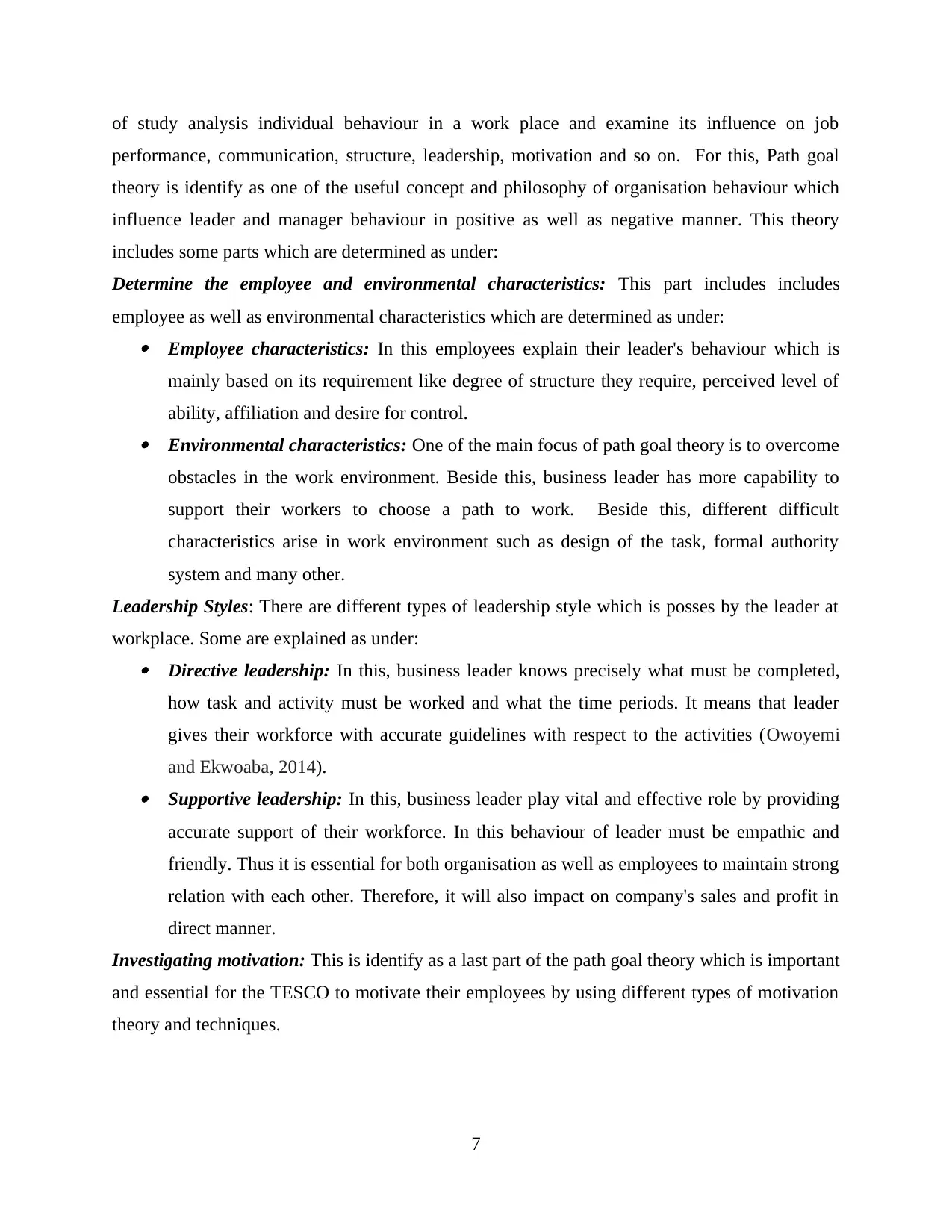
of study analysis individual behaviour in a work place and examine its influence on job
performance, communication, structure, leadership, motivation and so on. For this, Path goal
theory is identify as one of the useful concept and philosophy of organisation behaviour which
influence leader and manager behaviour in positive as well as negative manner. This theory
includes some parts which are determined as under:
Determine the employee and environmental characteristics: This part includes includes
employee as well as environmental characteristics which are determined as under: Employee characteristics: In this employees explain their leader's behaviour which is
mainly based on its requirement like degree of structure they require, perceived level of
ability, affiliation and desire for control. Environmental characteristics: One of the main focus of path goal theory is to overcome
obstacles in the work environment. Beside this, business leader has more capability to
support their workers to choose a path to work. Beside this, different difficult
characteristics arise in work environment such as design of the task, formal authority
system and many other.
Leadership Styles: There are different types of leadership style which is posses by the leader at
workplace. Some are explained as under: Directive leadership: In this, business leader knows precisely what must be completed,
how task and activity must be worked and what the time periods. It means that leader
gives their workforce with accurate guidelines with respect to the activities (Owoyemi
and Ekwoaba, 2014). Supportive leadership: In this, business leader play vital and effective role by providing
accurate support of their workforce. In this behaviour of leader must be empathic and
friendly. Thus it is essential for both organisation as well as employees to maintain strong
relation with each other. Therefore, it will also impact on company's sales and profit in
direct manner.
Investigating motivation: This is identify as a last part of the path goal theory which is important
and essential for the TESCO to motivate their employees by using different types of motivation
theory and techniques.
7
performance, communication, structure, leadership, motivation and so on. For this, Path goal
theory is identify as one of the useful concept and philosophy of organisation behaviour which
influence leader and manager behaviour in positive as well as negative manner. This theory
includes some parts which are determined as under:
Determine the employee and environmental characteristics: This part includes includes
employee as well as environmental characteristics which are determined as under: Employee characteristics: In this employees explain their leader's behaviour which is
mainly based on its requirement like degree of structure they require, perceived level of
ability, affiliation and desire for control. Environmental characteristics: One of the main focus of path goal theory is to overcome
obstacles in the work environment. Beside this, business leader has more capability to
support their workers to choose a path to work. Beside this, different difficult
characteristics arise in work environment such as design of the task, formal authority
system and many other.
Leadership Styles: There are different types of leadership style which is posses by the leader at
workplace. Some are explained as under: Directive leadership: In this, business leader knows precisely what must be completed,
how task and activity must be worked and what the time periods. It means that leader
gives their workforce with accurate guidelines with respect to the activities (Owoyemi
and Ekwoaba, 2014). Supportive leadership: In this, business leader play vital and effective role by providing
accurate support of their workforce. In this behaviour of leader must be empathic and
friendly. Thus it is essential for both organisation as well as employees to maintain strong
relation with each other. Therefore, it will also impact on company's sales and profit in
direct manner.
Investigating motivation: This is identify as a last part of the path goal theory which is important
and essential for the TESCO to motivate their employees by using different types of motivation
theory and techniques.
7
Paraphrase This Document
Need a fresh take? Get an instant paraphrase of this document with our AI Paraphraser
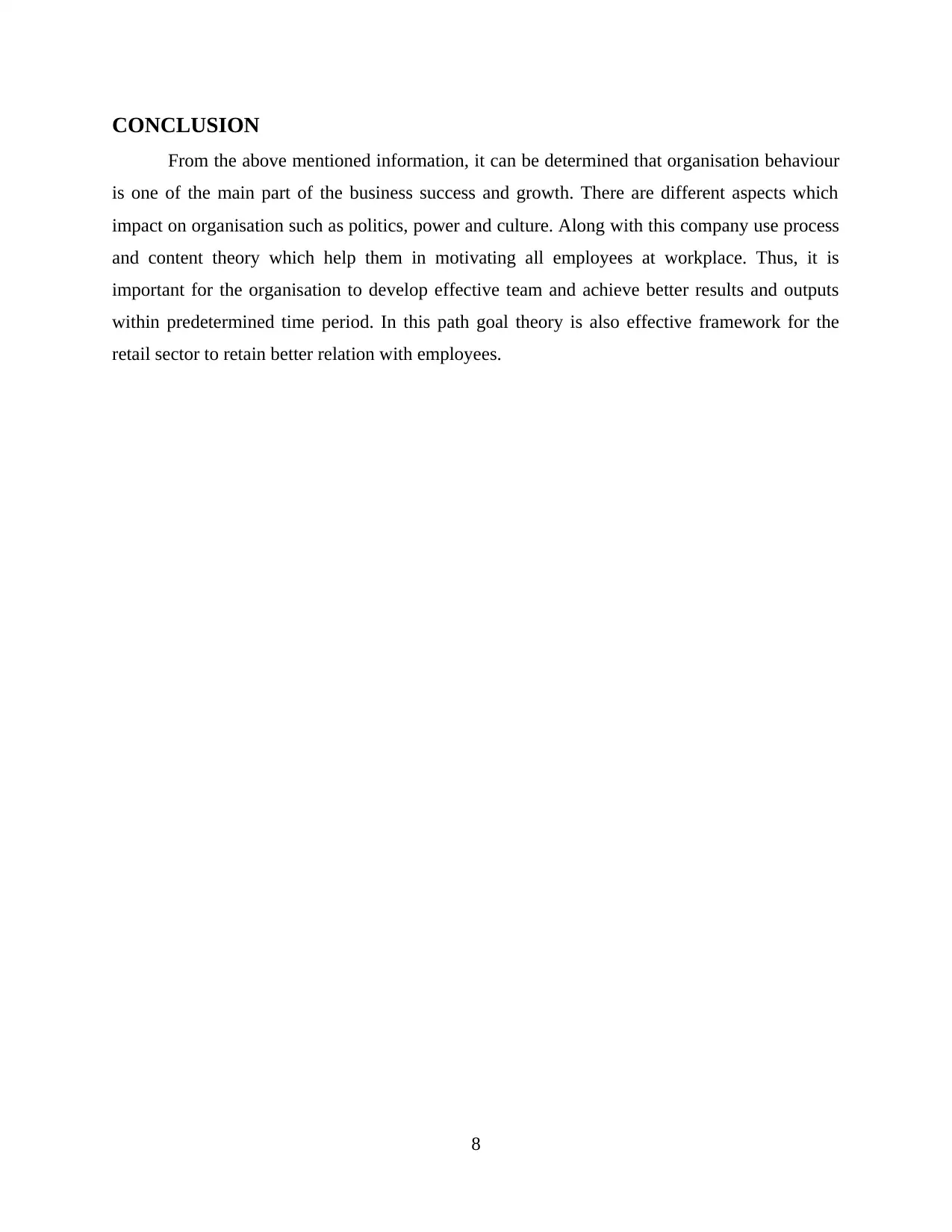
CONCLUSION
From the above mentioned information, it can be determined that organisation behaviour
is one of the main part of the business success and growth. There are different aspects which
impact on organisation such as politics, power and culture. Along with this company use process
and content theory which help them in motivating all employees at workplace. Thus, it is
important for the organisation to develop effective team and achieve better results and outputs
within predetermined time period. In this path goal theory is also effective framework for the
retail sector to retain better relation with employees.
8
From the above mentioned information, it can be determined that organisation behaviour
is one of the main part of the business success and growth. There are different aspects which
impact on organisation such as politics, power and culture. Along with this company use process
and content theory which help them in motivating all employees at workplace. Thus, it is
important for the organisation to develop effective team and achieve better results and outputs
within predetermined time period. In this path goal theory is also effective framework for the
retail sector to retain better relation with employees.
8

REFERENCES
Books and Journals
Chiboiwa, M. W., Chipunza, C. and Samuel, M. O., 2011. Evaluation of job satisfaction and
organisational citizenship behaviour: Case study of selected organisations in
Zimbabwe. African Journal of Business Management. 5(7). p.2910.
Dartey-Baah, K. and Amoako, G. K., 2011. Application of Frederick Herzberg's Two-Factor
theory in assessing and understanding employee motivation at work: a Ghanaian
Perspective. European Journal of Business and Management. 3(9). pp.1-8.
Farndale, E., Hope-Hailey, V. and Kelliher, C., 2011. High commitment performance
management: The roles of justice and trust. Personnel Review. 40(1). pp.5-23.
Francis, J. J., O’Connor, D. and Curran, J., 2012. Theories of behaviour change synthesised into
a set of theoretical groupings: introducing a thematic series on the theoretical domains
framework. Implementation Science. 7(1). p.35.
Gold, J. and et. al., 2013. Human resource development: Theory and practice. Palgrave
Macmillan.
Kasemsap, K., 2016. The role of knowledge sharing on organisational innovation: An integrated
framework. In Business intelligence: Concepts, methodologies, tools, and applications
(pp. 406-429). IGI Global.
Kaur, A., 2013. Maslow’s need hierarchy theory: Applications and criticisms. Global Journal of
Management and Business Studies. 3(10). pp.1061-1064.
LA, B., 2013. Will prescriptions for cultural change improve the NHS?. BMJ. 346. p.19.
Laforet, S., 2011. A framework of organisational innovation and outcomes in SMEs.
International Journal of Entrepreneurial Behavior & Research. 17(4). pp.380-408.
Michailova, S. and Sidorova, E., 2011. From group-based work to organisational learning: the
role of communication forms and knowledge sharing. Knowledge Management
Research & Practice. 9(1). pp.73-83.
Owoyemi, O. and Ekwoaba, J. O., 2014. Organisational Culture: A Tool for Management to
Control, Motivate and Enhance Employees’ Performance.
Online
Models of Organisational Culture - Handy, 2015. [Online]. Available through:
<https://www.tutor2u.net/business/reference/models-of-organisational-culture-handy/>.
9
Books and Journals
Chiboiwa, M. W., Chipunza, C. and Samuel, M. O., 2011. Evaluation of job satisfaction and
organisational citizenship behaviour: Case study of selected organisations in
Zimbabwe. African Journal of Business Management. 5(7). p.2910.
Dartey-Baah, K. and Amoako, G. K., 2011. Application of Frederick Herzberg's Two-Factor
theory in assessing and understanding employee motivation at work: a Ghanaian
Perspective. European Journal of Business and Management. 3(9). pp.1-8.
Farndale, E., Hope-Hailey, V. and Kelliher, C., 2011. High commitment performance
management: The roles of justice and trust. Personnel Review. 40(1). pp.5-23.
Francis, J. J., O’Connor, D. and Curran, J., 2012. Theories of behaviour change synthesised into
a set of theoretical groupings: introducing a thematic series on the theoretical domains
framework. Implementation Science. 7(1). p.35.
Gold, J. and et. al., 2013. Human resource development: Theory and practice. Palgrave
Macmillan.
Kasemsap, K., 2016. The role of knowledge sharing on organisational innovation: An integrated
framework. In Business intelligence: Concepts, methodologies, tools, and applications
(pp. 406-429). IGI Global.
Kaur, A., 2013. Maslow’s need hierarchy theory: Applications and criticisms. Global Journal of
Management and Business Studies. 3(10). pp.1061-1064.
LA, B., 2013. Will prescriptions for cultural change improve the NHS?. BMJ. 346. p.19.
Laforet, S., 2011. A framework of organisational innovation and outcomes in SMEs.
International Journal of Entrepreneurial Behavior & Research. 17(4). pp.380-408.
Michailova, S. and Sidorova, E., 2011. From group-based work to organisational learning: the
role of communication forms and knowledge sharing. Knowledge Management
Research & Practice. 9(1). pp.73-83.
Owoyemi, O. and Ekwoaba, J. O., 2014. Organisational Culture: A Tool for Management to
Control, Motivate and Enhance Employees’ Performance.
Online
Models of Organisational Culture - Handy, 2015. [Online]. Available through:
<https://www.tutor2u.net/business/reference/models-of-organisational-culture-handy/>.
9
⊘ This is a preview!⊘
Do you want full access?
Subscribe today to unlock all pages.

Trusted by 1+ million students worldwide
1 out of 12
Related Documents
Your All-in-One AI-Powered Toolkit for Academic Success.
+13062052269
info@desklib.com
Available 24*7 on WhatsApp / Email
![[object Object]](/_next/static/media/star-bottom.7253800d.svg)
Unlock your academic potential
Copyright © 2020–2025 A2Z Services. All Rights Reserved. Developed and managed by ZUCOL.




